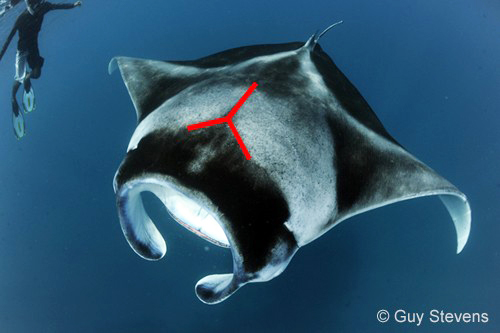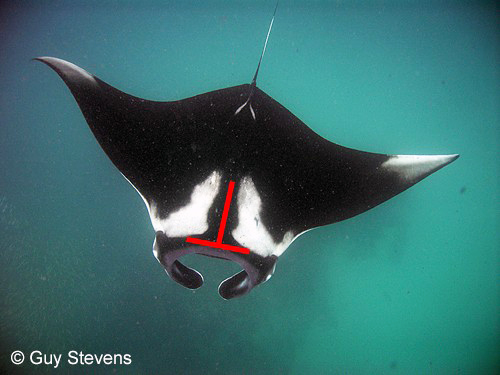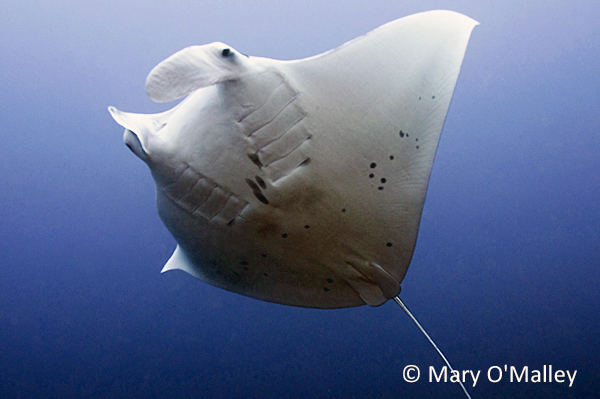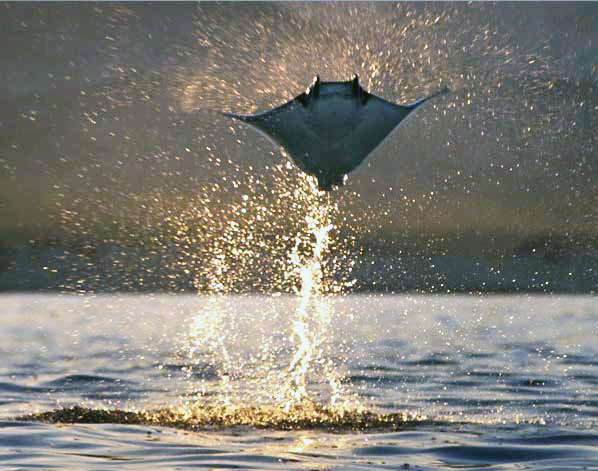Prior to June 2017, there were two species classified as genus Manta: Birostris and Alfredi. According to Marine Wildlife Philippines, the new taxonomy now classifies them as genus Mobula (White et al, 2017) as Mobula birostris and Mobula alfredi. Both mobula ray species are found in the Philippines, and are closely related to sharks, skates, and other rays. Collectively, they are Elasmobranch fish because they have skeletons made of cartilage instead of bone. Although related to Stingrays, the mobula rays have no stingers on their long whip-like tail, do not attack, and are not dangerous to humans. The mobula rays do not have a spiny tail as the Mobular Devil Ray, a close relative. Mobula rays are gentle giants. The mouths of mobula rays are right at the front, while the other rays have its mouth on the underside of the head. Mobula rays and mobular Devil Rays are the only ray species that have evolved from bottom feeders to filter feeders (Dean & Bizzarro, 2007).
Mobula birostris was first described by J.J. Walbaum in 1792 and J.A. Donndorff in 1798; while Mobula alfredi was first described by J.L.G. Krefft in 1868. Up until 2009, Mobula alfredi was lumped with Mobula birostris until differences in morphological features, habitat, and behaviors were pointed out. Both manta species belong to family Mobulidae.
Mobula birostris is called the Giant Mobula Ray, while the Mobula alfredi is called the Reef Mobula Ray. The Reef Mobula Ray lives inshore, near corals, rocky reefs and shallow waters along the coastline, while the Giant Manta Ray is oceanic, lives offshore, and highly migratory. Rare sightings of the Giant Mobula Ray suggest it undergoes significant seasonal migrations. The Giant Mobula Ray is elusive while the Reef Mobula Ray is curious and friendly, will approach, and locally migratory in short distances. The Giant Mobula Ray is similar in appearance to the Reef Mobula Ray. However, there are distinguishing features. The first difference is in size, as the adult Giant Mobula Ray is much bigger than the adult Reef Mobula Ray. Color pattern is a more effective way to distinguish one from the other, as well as their spots and markings, which are also used to identify individual rays in the wild.

Reef Mobula Ray (dorsal side)
The Reef Mobula Ray has a dark dorsal side with usually two lighter areas on top of the head, looking like a nuanced gradient of its dark dominating back coloration from whitish to greyish, and the longitudinal separation between these two lighter areas forms a “Y.” The Giant Mobula Ray has a much darker dorsal side, with two white areas sans a gradient effect. The line of separation between the two white areas forms a “T.” (Manta Trust)

Giant Mobula Ray (dorsal side)

Reef Mobula Ray (ventral side)

Giant Mobula Ray (ventral side)
The Reef Mobula Ray has a white ventral belly with spots between the gill slits and across the edge of its pectoral fins and abdomen. The Giant Mobula Ray has a white ventral belly with spots in the lower abdomen and a wide gray margin along its pectoral fins. Its cephalic fins on both sides the mouth and gill slits are black, while those of the Reef Mobula Ray are white. Cephalic fins help draw plankton to the mouth. The eyes are behind the cephalic fins. Behind each eye is a spiracle, an opening that draws in oxygenated water without having to use its gills.
The Giant Mobula Ray can span 22 feet, wingtip to wingtip and weigh over 3,500 lbs., making them the largest ray of more than 500 species of rays and skates. The Reef Mobula Ray is smaller, can span 18 feet, wingtip to wingtip, and can weigh up to about 3,000 lbs, making them the second largest ray among the rays and skates. Giant Mobula Rays have a circum-tropical and semi-temperate distribution throughout the world’s major oceans. However, actual populations are sparsely distributed and highly fragmented due to their specific resource and habitat needs. Giant Mobula Rays are, thus, rarely seen compared with the Reef Mobula Ray, despite their larger distribution across the globe.
The Giant Mobula Ray is a seasonal visitor to both coastal and offshore sites, brought on by upwelling of nutrients. While they may seem solitary, they can aggregate in large schools of >30 individuals to feed, mate, or clean. The few sightings of the Giant Mobula Rays are seasonal or sporadic, but in a few locations, their presence is a common occurrence. It is capable of deep dives and has been tracked down to depths exceeding 3,280 ft. (Marshall et al, 2011). The Reef Mobula Ray can dive to depths exceeding 1,300 ft. (Braun et al, 2014).
The Giant Mobula Ray occurs in tropical, sub-tropical and temperate waters of the Atlantic, Pacific and Indian Oceans, and is sighted in oceanic island groups, offshore pinnacles, and seamounts while visiting cleaning stations to have parasites removed, or to feed at the surface. The Reef Mobula Ray has a widespread distribution in tropical and subtropical waters worldwide, and is sighted in their inshore coastal habitats. The Reef Mobula Ray lives in an identical wide area with some short migrations in pursuit of zooplankton. They exhibit a sedentary behavior with precise areas for cleaning and feeding in close proximity to coasts, reefs or islands (Marshall et al, 2015).
Lifestyle. Mobula rays have a pelagic lifestyle, spending much of their time near the water’s surface, swimming continuously through the water column instead of resting on the sea floor like other rays. They may take to the air. When mobula rays jump out of the water in groups, it is a spectacle. They jump out of the water to play or dislodge parasites off their skin. They can sail several yards underwater to avoid predators at an escape speed of 15 mph.
Feeding. Mobula rays are filter feeders that primarily eat microscopic plankton and krill. As a mobula ray swims, it takes in seawater with the help of its cephalic fins on both sides of its mouth. The water then passes through the mobula’s comb-like gill rakers, tiny projections on the gills that filter food while water exits through the gills. A full-grown adult can consume about 60 lbs of food daily. As mobulas have the largest brain to body weight ratio among shark or ray species, they remember the best feeding grounds (Ari & D’Agostino, 2016).
Reproduction. The mating season is triggered by a full moon and initiated by the pursuing male. The mobula ray gives birth to a live pup that hatches and develops from an egg inside the mother. Thus, the mobula ray is ovoviviparous, meaning, the fertilized egg develops within the mother’s oviduct and is enclosed in an egg case as the developing embryo feeds on the yolk. After the egg hatches, the pup remains in the oviduct and receives nourishment from a milky secretion (Marshall & Bennett, 2010). Since the pup does not have an umbilical cord to its mother, the pup obtains oxygen and nutrients through the uterine wall (Tomita et al, 2012). Mobula rays only reproduce at 8 to 10 years of age. The gestation period takes about a year, and only one pup is born every 2-3 years. One female may give birth to only 10 pups in her lifetime, and this low reproductive rate is one reason why the mobula ray population is Vulnerable. When fully developed, the pup is 4 ft 7” in width, and weighs 20 lbs. It is expelled from the mother’s oviduct, usually near the coast, and remains in shallow-waters for a few years while it grows (Marshall & Bennett, 2010). Research indicates that mobula rays can live to at least 50 years of age, if not over-fished.
Sightings in the Philippines. The rare Giant Mobula Rays have been sighted living near the islands of Pamilacan and Malapascua in Cebu, and in the Sulu Sea. The Reef Mobula Rays have been sighted living near the coastlines of Bohol Sea, and Donsol in Sorsogon; El Nido Islands, and Tubbataha Reef Park in Palawan. The Bohol Sea is an important habitat for large marine animals that benefit from the seasonal upwelling of cold, nutrient-rich water from the deep to the upper layers. Both mobula species can be found at the Manta Bowl at Ticao Pass, Masbate. The Manta Bowl Shoal is an underwater atoll, which covers about an 8-hectare flat area. The shoal is in the middle of the ocean and has little protection from winds or waves. Manta Bowl is the Mobula Ray capital of the Philippines, the habitat of the world’s biggest ray. Ticao Pass has one of the world’s highest concentration of plankton due to the strong currents from the San Bernardino Strait. These currents push large groups of plankton and other organisms to gather in the area, making this an ideal cleaning and feeding station for the manta ray.
Threats. Mobula rays are killed or captured by harpoon, netting, trawling, gaff hooks, hand spears, gillnets, longlines, driftnets, and purse seines. They are easy to target because of their large size, very slow swimming speed, aggregative behavior, predictable habitat use, and lack of human avoidance. Over-fishing is the main threat to mobula rays around the world, whether the fishing is artisanal, targeted, or bycatch, since many mobula ray fisheries are unregulated or underreported. Certain monitored subpopulations of Giant Mobula Rays have been depleted as a result of sustained pressure from fishing. Of particular concern is the targeting of Giant Mobula Rays at critical habitats or well-known aggregation sites where numerous mobula rays can be targeted with relatively low catch-per-unit-effort (CPUE).
A study in Pamilacan Island, Cebu reported that up to 1,000 rays, particularly Giant Mobula Rays and a few species of the genus Mobula (e.g., Devil Ray) are harvested annually in directed fisheries. Over 35 villages participated in this fishery. The season is from September until June the following year, and peaks in November and December. Although these targeted fisheries have been active for generations, some claiming since the 1800s and others since the mid 1950s, the fishermen noted that CPUE and overall number of rays have declined significantly in recent times. Japanese sports divers suggest that the Giant Mobula Rays population at one site in the Sulu Sea fell by 50%-66% in 7 years from the end of the 1980s (M. Nishitani). The Fishermen reported a decrease in catch and landings since the record landings in the 1960s.
Mobula rays are in high demand in international trade markets. Their cartilage is used as filler in shark fin soup, and their skin is used to produce shoes, wallets, and sandpaper. In many traditional Chinese communities, manta ray gill rakers are believed to treat a variety of ailments, including cancer, without any proven scientific basis (Manta Trust, 2016). Because of high medicinal demand, mobula gill rakers can sell for $200 per pound. A single dead mobula ray can fetch $50. Other threats to mobula rays include boat strikes, habitat loss, climate change, and pollution. Global populations have decreased by more than 30%, or 80% in some regions, over the last 75 years.
Conservation. The International Union for Conservation of Nature (IUCN) 2016 redlists both Giant and Reef Mobula Ray species as Vulnerable because of their rapid decrease in population due to over-fishing, uncompensated by their late sexual maturity and low birth rate. The Convention on the Conservation of Migratory Species of Wild Animals (CMS) Appendices I and II lists the Giant Mobula Ray as a species of international concern. The Philippines has taken steps to protect mobula rays although these laws are not always enforced. The Convention on International Trade in Endangered Species (CITES) Annex II provides protection to both the Giant and Reef Mobula Rays in the Philippines.
Dive tourism involving mobula rays is a growing industry and has demonstrated that sustainable tourism significantly enhances their economic value in comparison to short-term returns from fishing. The estimated value of a single mobula ray over its lifetime is $1M because it provides repeated ecotourism opportunities. The estimated yearly value for the gill raker trade is $11M compared to the yearly estimated value of mobula dive tourism, which is $27M. Despite its higher ecological and economic importance than trade, mobula rays are still increasingly threatened by human activity.
The Philippine Mobula Ray Project finds there is inadequate enforcement of the mobula ray fishing ban, and that new target fisheries are on the rise to supply the gill raker trade. Not only does this trend have severe implications for the mobula species and the country’s ecosystem health, but it may also lead to economic hardship for coastal communities that rely on mobula meat for income, food security, and mobula tourism. Mobula ray fishing was banned in the Philippines in 1998, but was lifted in 1999 due to pressure from fishermen. In a yearlong survey covering March 2002-2003, there were 156 Giant Mobula Rays caught between November and January. Since then, the mobula ray ban has been reinstated, and mobula rays are now rare in the Philippines, especially in Bohol Sea where the fishery study was focused (Manta Trust). Planktonic productivity occurs from November to April in Bohol Sea (Cabrera et al, 2011; Gordon et al, 2011) and coincides with seasonal visits of large planktivorous elasmobranchs such as mobula rays (Rayos et al, 2012).
Although mobula rays have been traditionally fished for centuries for food, the increase in landings is suspected to supply the gill plate trade instead. Most of this catch is illegal, unregulated, and unreported. The Philippines has an excellent Fisheries Code (R.A.8550) but it struggles to implement the act particularly at the Municipal Government level, which has responsibility for waters within 15 km, where the majority of fishing takes place. According to catch data, most rays are being landed at Municipal waters. Thus, the Philippine Mobula Ray Project recommends that since mobula rays have such high vulnerability to fishing pressures, incidents of increased landings need to be reported, confirmed, and acted upon swiftly if the remaining populations of these rays are to survive within this region (Manta Trust).
In the 2013 Redlist Assessment for Marine Mammals published by Marine Wildlife Watch of the Philippines (MWWP) and DENR-BFAR-DA, it finds that when whale sharks and mobula rays are beached, they suffer from asphyxiation as they can only respire in water. Exposure to the sun can dehydrate and overheat their body quickly, and their skin is susceptible to abrasions when out of the water. When a live mobula ray is beached, it should be immediately placed back into the water to allow respiration to take place, and, the mobula should be facing the sea since it cannot swim backwards. Mobula rays are very delicate and can easily perish, thus time is of the essence during beaching incidents.
